Nanoscale Dots, Grids, Ripples, and Hierarchical Structures on PET by UV Laser Processing
Abstract
1. Introduction
2. Materials and Methods
2.1. Fabrication of Structures on PET
2.1.1. Materials
2.1.2. General Setup for Varying the Angle of Incidence, Pulse Number, and Fluence
2.1.3. Adaptations and Amendments of the Setup for Fabrication of Irregular Ripples, Water Layer Usage, Substrate Cooling, and Superposition of Two Polarization Directions
2.2. Scanning Electron Microscopy (SEM) Images
2.3. Focused Ion Beam (FIB) Cuts
2.4. Computation of Morphological Features
2.4.1. Spatial Periods of Regular Ripples
2.4.2. Peak–Peak Distances of Surface Features
2.4.3. Areas, Distances, and Radii of Nanodots
3. Results
3.1. Nanoripples
3.1.1. Change in the Angle of Incidence
3.1.2. Change with the Pulse Number
3.1.3. LIPSS on Ultrathin PET Foils
3.1.4. Changes Due to an Increase in Fluence
3.1.5. Change in Ripple Morphology Due to Substrate Cooling and a Water Layer
3.2. Nanodots Due to a Decrease in Fluence
3.3. Nanoscale Grids and Hierarchical Structures Due to Superposition of Two Polarization Directions
4. Discussion
4.1. Nanoripples
4.2. Nanodots Due to a Decrease in Fluence
4.3. Nanoscale Grids and Hierarchical Structures Due to Superposition of Two Polarization Directions
5. Conclusions
Author Contributions
Funding
Data Availability Statement
Acknowledgments
Conflicts of Interest
References
- Xiao, G.; He, Y.; Liu, S.; Yi, H.; Du, L. Laser Processing of Micro/Nano Biomimetic Structures. Micro Nano Lett. 2021, 16, 327–335. [Google Scholar] [CrossRef]
- Lasagni, A.F.; Alamri, S.; Aguilar-Morales, A.I.; Rößler, F.; Voisiat, B.; Kunze, T. Biomimetic Surface Structuring Using Laser Based Interferometric Methods. Appl. Sci. 2018, 8, 1260. [Google Scholar] [CrossRef]
- Hancock, M.J.; Sekeroglu, K.; Demirel, M.C. Bioinspired Directional Surfaces for Adhesion, Wetting and Transport. Adv. Funct. Mater. 2012, 22, 2223–2234. [Google Scholar] [CrossRef] [PubMed]
- Buchberger, G.; Meyer, M.; Plamadeala, C.; Weissbach, M.; Hesser, G.; Baumgartner, W.; Heitz, J.; Joel, A.-C. Robustness of Antiadhesion between Nanofibers and Surfaces Covered with Nanoripples of Varying Spatial Period. Front. Ecol. Evol. 2023, 11, 1149051. [Google Scholar] [CrossRef] [PubMed]
- Meyer, M.; Buchberger, G.; Heitz, J.; Baiko, D.; Joel, A.C. Ambient Climate Influences Anti-Adhesion between Biomimetic Structured Foil and Nanofibers. Nanomaterials 2021, 11, 3222. [Google Scholar] [CrossRef] [PubMed]
- Kirner, S.V.; Hermens, U.; Mimidis, A.; Skoulas, E.; Florian, C.; Hischen, F.; Plamadeala, C.; Baumgartner, W.; Winands, K.; Mescheder, H.; et al. Mimicking Bug-like Surface Structures and Their Fluid Transport Produced by Ultrashort Laser Pulse Irradiation of Steel. Appl. Phys. A 2017, 123, 754. [Google Scholar] [CrossRef]
- Zorba, V.; Stratakis, E.; Barberoglou, M.; Spanakis, E.; Tzanetakis, P.; Anastasiadis, S.H.; Fotakis, C. Biomimetic Artificial Surfaces Quantitatively Reproduce the Water Repellency of a Lotus Leaf. Adv. Mater. 2008, 20, 4049–4054. [Google Scholar] [CrossRef]
- Liu, Q.; Zhang, J.; Sun, P.; Wang, J.; Zhao, W.; Zhao, G.; Chen, N.; Yang, Y.; Li, L.; He, N.; et al. Achieving Ultralong Directional Liquid Transportation Spontaneously with a High Velocity. J. Mater. Chem. A Mater. 2023, 11, 10164–10173. [Google Scholar] [CrossRef]
- Lee, M.; Oh, J.; Lim, H.; Lee, J. Enhanced Liquid Transport on a Highly Scalable, Cost-Effective, and Flexible 3D Topological Liquid Capillary Diode. Adv. Funct. Mater. 2021, 31, 2011288. [Google Scholar] [CrossRef]
- Sun, J.; Bhushan, B.; Tong, J. Structural Coloration in Nature. RSC Adv. 2013, 3, 14862–14889. [Google Scholar] [CrossRef]
- Liu, Y.; Li, S.; Niu, S.; Cao, X.; Han, Z.; Ren, L. Bio-Inspired Micro-Nano Structured Surface with Structural Color and Anisotropic Wettability on Cu Substrate. Appl. Surf. Sci. 2016, 379, 230–237. [Google Scholar] [CrossRef]
- Stratakis, E.; Jeon, H.; Koo, S. Structures for Biomimetic, Fluidic, and Biological Applications. MRS Bull. 2016, 41, 993–1001. [Google Scholar] [CrossRef]
- Stoian, R.; Bonse, J. (Eds.) Ultrafast Laser Nanostructuring; Springer Series in Optical Sciences; Springer International Publishing: Cham, Switzerland, 2023; Volume 239, ISBN 978-3-031-14751-7. [Google Scholar]
- Rebollar, E.; Castillejo, M.; Ezquerra, T.A. Laser Induced Periodic Surface Structures on Polymer Films: From Fundamentals to Applications. Eur. Polym. J. 2015, 73, 162–174. [Google Scholar] [CrossRef]
- Aravind, A.; Jayaraj, M.K.; Kumar, M.; Chandra, R. The Dependence of Structural and Optical Properties of PLD Grown ZnO Films on Ablation Parameters. Appl. Surf. Sci. 2013, 286, 54–60. [Google Scholar] [CrossRef]
- Lorusso, A.; Nassisi, V.; Congedo, G.; Lovergine, N.; Velardi, L.; Prete, P. Pulsed Plasma Ion Source to Create Si Nanocrystals in SiO 2 Substrates. Appl. Surf. Sci. 2009, 255, 5401–5404. [Google Scholar] [CrossRef]
- Stefan, N.; Mulenko, S.A.; Skoryk, M.A.; Popov, V.M.; Smirnov, A.B. Influence of Hybrid Fe/Cr Parameters Structures Synthesised with Laser Radiation on Their Photosensitivity. J. Mater. Sci. Mater. Electron. 2023, 34, 1830. [Google Scholar] [CrossRef]
- Bonse, J.; Hohm, S.; Kirner, S.V.; Rosenfeld, A.; Kruger, J. Laser-Induced Periodic Surface Structures—A Scientific Evergreen. IEEE J. Sel. Top. Quantum Electron. 2017, 23, 9000615. [Google Scholar] [CrossRef]
- Bäuerle, D.W. Laser Processing and Chemistry, 4th ed.; Springer: Berlin/Heidelberg, Germany, 2011; ISBN 9783642176128. [Google Scholar]
- Bonse, J. Quo Vadis LIPSS?—Recent and Future Trends on Laser-Induced Periodic Surface Structures. Nanomaterials 2020, 10, 1950. [Google Scholar] [CrossRef] [PubMed]
- Van Driel, H.M.; Sipe, J.E.; Young, J.F. Laser-Induced Periodic Surface Structure on Solids: A Universal Phenomenon. Phys. Rev. Lett. 1982, 49, 1955–1958. [Google Scholar] [CrossRef]
- Cui, J.; Nogales, A.; Ezquerra, T.A.; Rebollar, E. Influence of Substrate and Film Thickness on Polymer LIPSS Formation. Appl. Surf. Sci. 2017, 394, 125–131. [Google Scholar] [CrossRef]
- Rodríguez-Beltrán, R.I.; Hernandez, M.; Paszkiewicz, S.; Szymczyk, A.; Rosłaniec, Z.; Ezquerra, T.A.; Castillejo, M.; Moreno, P.; Rebollar, E. Laser Induced Periodic Surface Structures Formation by Nanosecond Laser Irradiation of Poly (Ethylene Terephthalate) Reinforced with Expanded Graphite. Appl. Surf. Sci. 2018, 436, 1193–1199. [Google Scholar] [CrossRef]
- Barb, R.A.; Hrelescu, C.; Dong, L.; Heitz, J.; Siegel, J.; Slepicka, P.; Vosmanska, V.; Svorcik, V.; Magnus, B.; Marksteiner, R.; et al. Laser-Induced Periodic Surface Structures on Polymers for Formation of Gold Nanowires and Activation of Human Cells. Appl. Phys. A Mater. Sci. Process 2014, 117, 295–300. [Google Scholar] [CrossRef]
- Siegel, J.; Heitz, J.; Švorčík, V. Self-Organized Gold Nanostructures on Laser Patterned PET. Surf. Coat. Technol. 2011, 206, 517–521. [Google Scholar] [CrossRef]
- Slepička, P.; Chaloupka, A.; Sajdl, P.; Heitz, J.; Hnatowicz, V.; Švorčík, V. Angle Dependent Laser Nanopatterning of Poly(Ethylene Terephthalate) Surfaces. Appl. Surf. Sci. 2011, 257, 6021–6025. [Google Scholar] [CrossRef]
- Siegel, J.; Slepička, P.; Heitz, J.; Kolská, Z.; Sajdl, P.; Švorčík, V. Gold Nano-Wires and Nano-Layers at Laser-Induced Nano-Ripples on PET. Appl. Surf. Sci. 2010, 256, 2205–2209. [Google Scholar] [CrossRef]
- Rebollar, E.; Pérez, S.; Hernández, J.J.; Martín-Fabiani, I.; Rueda, D.R.; Ezquerra, T.A.; Castillejo, M. Assessment and Formation Mechanism of Laser-Induced Periodic Surface Structures on Polymer Spin-Coated Films in Real and Reciprocal Space. Langmuir 2011, 27, 5596–5606. [Google Scholar] [CrossRef] [PubMed]
- Rebollar, E.; Pérez, S.; Hernández, M.; Domingo, C.; Martín, M.; Ezquerra, T.A.; García-Ruiz, J.P.; Castillejo, M. Physicochemical Modifications Accompanying UV Laser Induced Surface Structures on Poly(Ethylene Terephthalate) and Their Effect on Adhesion of Mesenchymal Cells. Phys. Chem. Chem. Phys. 2014, 16, 17551–17559. [Google Scholar] [CrossRef] [PubMed]
- Bonse, J.; Gräf, S. Maxwell Meets Marangoni—A Review of Theories on Laser-Induced Periodic Surface Structures. Laser Photon. Rev. 2020, 14, 2000215. [Google Scholar] [CrossRef]
- Bäuerle, D.; Arenholz, E.; Heitz, J.; Proyer, S.; Stangl, E.; Luk’yanchuk, B. Surface Patterning and Thin-Film Formation by Pulsed-Laser Ablation. Mater. Sci. Forum 1994, 173–174, 41–52. [Google Scholar] [CrossRef]
- Richter, A.M.; Buchberger, G.; Stifter, D.; Duchoslav, J.; Hertwig, A.; Bonse, J.; Heitz, J.; Schwibbert, K. Spatial Period of Laser-Induced Surface Nanoripples on PET Determines Escherichia coli Repellence. Nanomaterials 2021, 11, 3000. [Google Scholar] [CrossRef] [PubMed]
- Wong, W.; Chan, K.; Yeung, K.W.; Lau, K.S. Surface Structuring of Poly(Ethylene Terephthalate) by UV Excimer Laser. J. Mater. Process Technol. 2003, 132, 114–118. [Google Scholar] [CrossRef]
- Wong, M.; Lau, K.S.; Chan, K. Sub-Micrometer Periodic Surface Structure Produced on PET Fibres with a Low-Fluence Ultraviolet Excimer Laser. Res. J. Text. Appar. 2003, 7, 29–37. [Google Scholar] [CrossRef]
- Siegel, J.; Šuláková, P.; Kaimlová, M.; Švorčík, V.; Hubáček, T. Underwater Laser Treatment of PET: Effect of Processing Parameters on Surface Morphology and Chemistry. Appl. Sci. 2018, 8, 2389. [Google Scholar] [CrossRef]
- Lai, S.; Liu, Y.; Gong, L.; Zhao, Y.; Zhang, C.; Han, B. Laser-Induced Surface Structures at Polymer Surfaces Irradiated by Ns-UV-Laser in Water Confinement and in Air. Opt. Laser Technol. 2024, 168, 109871. [Google Scholar] [CrossRef]
- Ehrhardt, M.; Lai, S.; Lorenz, P.; Zajadacz, J.; Han, B.; Zimmer, K. Self-Organized Submicron Structures in Photoresist Films by UV-Laser Irradiation at Water-Confined Conditions. Appl. Phys. A 2023, 129, 623. [Google Scholar] [CrossRef]
- Wong, W.; Chan, K.; Yeung, K.W.; Lau, K.S. Chemical Surface Modification of Poly (Ethylene Terephthalate) by Excimer Irradiation of High and Low Intensities. Mater. Res. Innov. 2001, 4, 344–349. [Google Scholar] [CrossRef]
- Watanabe, H.; Takata, T. Excimer Laser Radiation—Chemical and Polymer Surface Modification Due to Physical Changes in the Surface Structure of Poly(Ethylene Terephthalate). Polym. Int. 1993, 49, 274–278. [Google Scholar] [CrossRef]
- Steinhauser, B.; Vidal, C.; Barb, R.A.; Heitz, J.; Mardare, A.I.; Hassel, A.W.; Hrelescu, C.; Klar, T.A. Localized-Plasmon Voltammetry to Detect PH Dependent Gold Oxidation. J. Phys. Chem. C 2018, 122, 4565–4571. [Google Scholar] [CrossRef]
- Krajcar, R.; Siegel, J.; Slepička, P.; Fitl, P.; Švorčík, V. Silver Nanowires Prepared on PET Structured by Laser Irradiation. Mater. Lett. 2014, 117, 184–187. [Google Scholar] [CrossRef]
- Melzer, M.; Kaltenbrunner, M.; Makarov, D.; Karnaushenko, D.; Karnaushenko, D.; Sekitani, T.; Someya, T.; Schmidt, O.G. Imperceptible Magnetoelectronics. Nat. Commun. 2015, 6, 6080. [Google Scholar] [CrossRef]
- Drack, M.; Graz, I.; Sekitani, T.; Someya, T.; Kaltenbrunner, M.; Bauer, S. An Imperceptible Plastic Electronic Wrap. Adv. Mater. 2014, 27, 34–40. [Google Scholar] [CrossRef] [PubMed]
- Riveiro, A.; Maçon, A.L.B.; del Val, J.; Comesaña, R.; Pou, J. Laser Surface Texturing of Polymers for Biomedical Applications. Front. Phys. 2018, 5, 16. [Google Scholar] [CrossRef]
- Shukla, P.; Waugh, D.G.; Lawrence, J.; Vilar, R. Laser Surface Structuring of Ceramics, Metals and Polymers for Biomedical Applications: A Review; Elsevier Ltd.: Amsterdam, The Netherlands, 2016; ISBN 9780081009420. [Google Scholar]
- König, K.; Ostendorf, A. Optically Induced Nanostructures: Biomedical and Technical Applications; De Gruyter: Berlin, Germany, 2015. [Google Scholar]
- Rebollar, E.; Frischauf, I.; Olbrich, M.; Peterbauer, T.; Hering, S.; Preiner, J.; Hinterdorfer, P.; Romanin, C.; Heitz, J. Proliferation of Aligned Mammalian Cells on Laser-Nanostructured Polystyrene. Biomaterials 2008, 29, 1796–1806. [Google Scholar] [CrossRef] [PubMed]
- Kalachyova, Y.; Mares, D.; Jerabek, V.; Ulbrich, P.; Lapcak, L.; Svorcik, V.; Lyutakov, O. Ultrasensitive and Reproducible SERS Platform of Coupled Ag Grating with Multibranched Au Nanoparticles. Phys. Chem. Chem. Phys. 2017, 19, 14761–14769. [Google Scholar] [CrossRef] [PubMed]
- Erzina, M.; Trelin, A.; Guselnikova, O.; Dvorankova, B.; Strnadova, K.; Perminova, A.; Ulbrich, P.; Mares, D.; Jerabek, V.; Elashnikov, R.; et al. Precise Cancer Detection via the Combination of Functionalized SERS Surfaces and Convolutional Neural Network with Independent Inputs. Sens. Actuators B Chem. 2020, 308, 127660. [Google Scholar] [CrossRef]
- Schindelin, J.; Arganda-Carreras, I.; Frise, E.; Kaynig, V.; Longair, M.; Pietzsch, T.; Preibisch, S.; Rueden, C.; Saalfeld, S.; Schmid, B.; et al. Fiji: An Open-Source Platform for Biological-Image Analysis. Nat. Methods 2012, 9, 676–682. [Google Scholar] [CrossRef] [PubMed]
- Csete, M.; Marti, O.; Bor, Z. Laser-Induced Periodic Surface Structures on Different Poly-Carbonate Films. Appl. Phys. A Mater. Sci. Process 2001, 73, 521–526. [Google Scholar] [CrossRef]
- Barbero, C.A.; Acevedo, D.F. Manufacturing Functional Polymer Surfaces by Direct Laser Interference Patterning (DLIP): A Polymer Science View. Nanomanufacturing 2022, 2, 229–264. [Google Scholar] [CrossRef]
- Meinshausen, A.K.; Herbster, M.; Zwahr, C.; Soldera, M.; Müller, A.; Halle, T.; Lasagni, A.F.; Bertrand, J. Aspect Ratio of Nano/Microstructures Determines Staphylococcus aureus Adhesion on PET and Titanium Surfaces. J. Appl. Microbiol. 2021, 131, 1498–1514. [Google Scholar] [CrossRef]
- Chen, Y. Nanofabrication by Electron Beam Lithography and Its Applications: A Review. Microelectron. Eng. 2015, 135, 57–72. [Google Scholar] [CrossRef]
- Baglin, J.E.E. Ion Beam Nanoscale Fabrication and Lithography—A Review. Appl. Surf. Sci. 2012, 258, 4103–4111. [Google Scholar] [CrossRef]
- Parker, A.R. Discovery of Functional Iridescence and Its Coevolution with Eyes in the Phylogeny of Ostracoda (Crustacea). Proc. Biol. Sci. 1995, 262, 349–355. [Google Scholar]
- Vorobyev, A.Y.; Guo, C. Colorizing Metals with Femtosecond Laser Pulses. Appl. Phys. Lett. 2008, 92, 041914. [Google Scholar] [CrossRef]
- Ou, Z.; Huang, M.; Zhao, F. Colorizing Pure Copper Surface by Ultrafast Laser-Induced near-Subwavelength Ripples. Opt. Express 2014, 22, 17254. [Google Scholar] [CrossRef] [PubMed]
- Hale, G.M.; Querry, M.R. Optical Constants of Water in the 200-Nm to 200-Μm Wavelength Region. Appl. Opt. 1973, 12, 555. [Google Scholar] [CrossRef] [PubMed]
- Albu, C.; Dinescu, A.; Filipescu, M.; Ulmeanu, M.; Zamfirescu, M. Periodical Structures Induced by Femtosecond Laser on Metals in Air and Liquid Environments. Appl. Surf. Sci. 2013, 278, 347–351. [Google Scholar] [CrossRef]
- Gao, W.; Zheng, K.; Liao, Y.; Du, H.; Liu, C.; Ye, C.; Liu, K.; Xie, S.; Chen, C.; Chen, J.; et al. High-Quality Femtosecond Laser Surface Micro/Nano-Structuring Assisted by A Thin Frost Layer. Adv. Mater. Interfaces 2023, 10, 2201924. [Google Scholar] [CrossRef]
- Elaboudi, I.; Lazare, S.; Belin, C.; Talaga, D.; Labrugère, C. Underwater Excimer Laser Ablation of Polymers. Appl. Phys. A 2008, 92, 743–748. [Google Scholar] [CrossRef]
- Slepička, P.; Neděla, O.; Siegel, J.; Krajcar, R.; Kolská, Z.; Švorčík, V. Ripple Polystyrene Nano-Pattern Induced by KrF Laser. Express Polym. Lett. 2014, 8, 459–466. [Google Scholar] [CrossRef]
- Csete, M.; Bor, Z. Laser-Induced Periodic Surface Structure Formation on Polyethylene-Terephthalate. Appl. Surf. Sci. 1998, 133, 5–16. [Google Scholar] [CrossRef]
- Kaltenbrunner, M.; White, M.S.; Głowacki, E.D.; Sekitani, T.; Someya, T.; Sariciftci, N.S.; Bauer, S. Ultrathin and Lightweight Organic Solar Cells with High Flexibility. Nat. Commun. 2012, 3, 770. [Google Scholar] [CrossRef]
- Chowdhury, D.; Mohamed, S.A.; Manzato, G.; Siri, B.; Chittofrati, R.; Giordano, M.C.; Hussein, M.; Hameed, M.F.O.; Obayya, S.S.A.; Stadler, P.; et al. Broadband Photon Harvesting in Organic Photovoltaic Devices Induced by Large-Area Nanogrooved Templates. ACS Appl. Nano Mater. 2023, 6, 6230–6240. [Google Scholar] [CrossRef]
- Rebollar, E.; Vázquez De Aldana, J.R.; Martín-Fabiani, I.; Hernández, M.; Rueda, D.R.; Ezquerra, T.A.; Domingo, C.; Moreno, P.; Castillejo, M. Assessment of Femtosecond Laser Induced Periodic Surface Structures on Polymer Films. Phys. Chem. Chem. Phys. 2013, 15, 11287–11298. [Google Scholar] [CrossRef]
- Fang, Z.; Zhu, X. Plasmonics in Nanostructures. Adv. Mater. 2013, 25, 3840–3856. [Google Scholar] [CrossRef] [PubMed]
- Michaljaničová, I.; Slepička, P.; Veselý, M.; Kolská, Z.; Švorčík, V. Nanowires and Nanodots Prepared with Polarized KrF Laser on Polyethersulphone. Mater. Lett. 2015, 144, 15–18. [Google Scholar] [CrossRef]
- Porta-Velilla, L.; Turan, N.; Cubero, Á.; Shao, W.; Li, H.; de la Fuente, G.F.; Martínez, E.; Larrea, Á.; Castro, M.; Koralay, H.; et al. Highly Regular Hexagonally-Arranged Nanostructures on Ni-W Alloy Tapes upon Irradiation with Ultrashort UV Laser Pulses. Nanomaterials 2022, 12, 2380. [Google Scholar] [CrossRef] [PubMed]
- Mezera, M.; Alamri, S.; Hendriks, W.A.P.M.; Hertwig, A.; Elert, A.M.; Bonse, J.; Kunze, T.; Lasagni, A.F.; Römer, G.W.R.B.E. Hierarchical Micro-/Nano-Structures on Polycarbonate via Uv Pulsed Laser Processing. Nanomaterials 2020, 10, 1184. [Google Scholar] [CrossRef] [PubMed]
- Ehrhardt, M.; Lai, S.; Lorenz, P.; Zimmer, K. Guiding of LIPSS Formation by Excimer Laser Irradiation of Pre-Patterned Polymer Films for Tailored Hierarchical Structures. Appl. Surf. Sci. 2020, 506, 144785. [Google Scholar] [CrossRef]
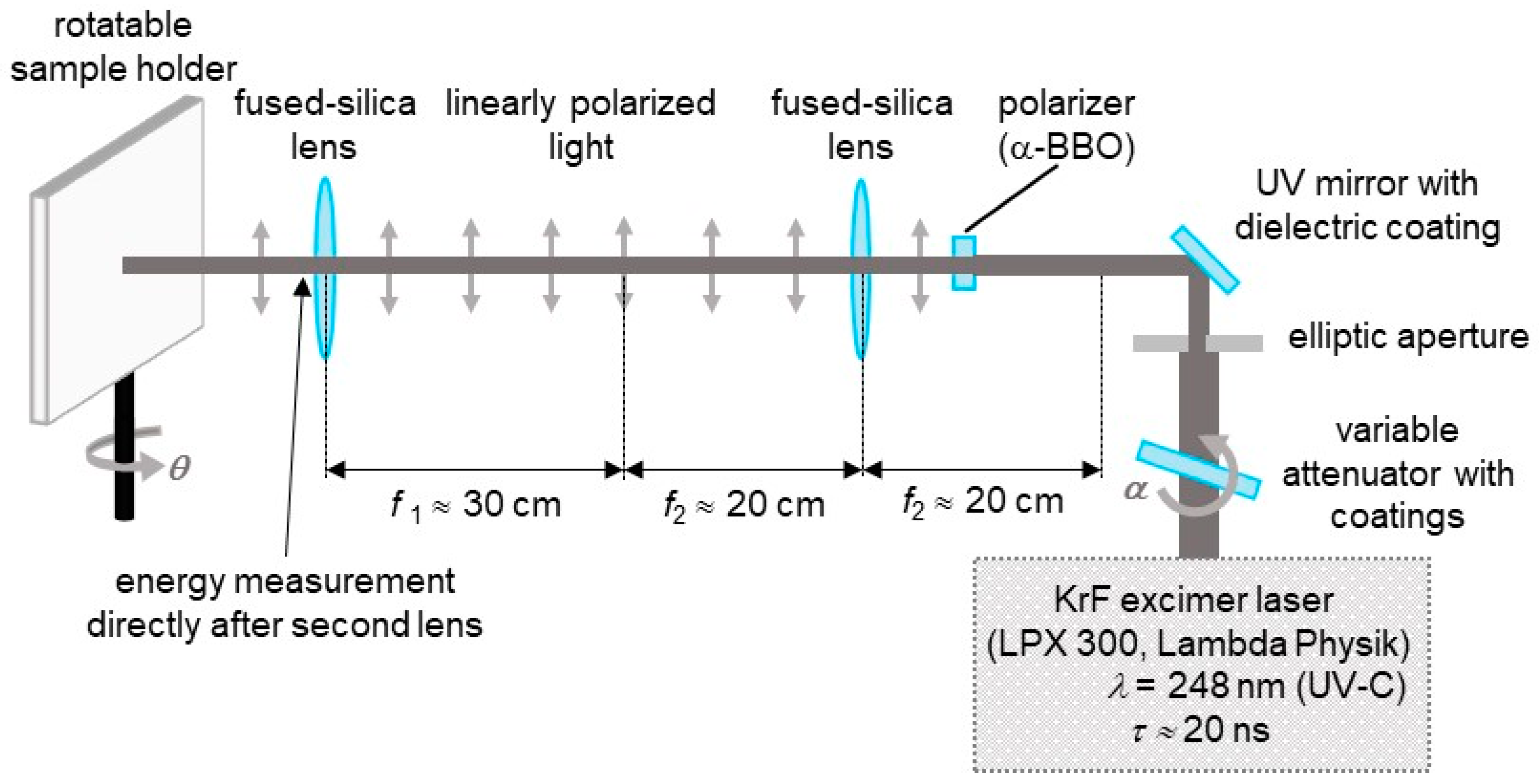
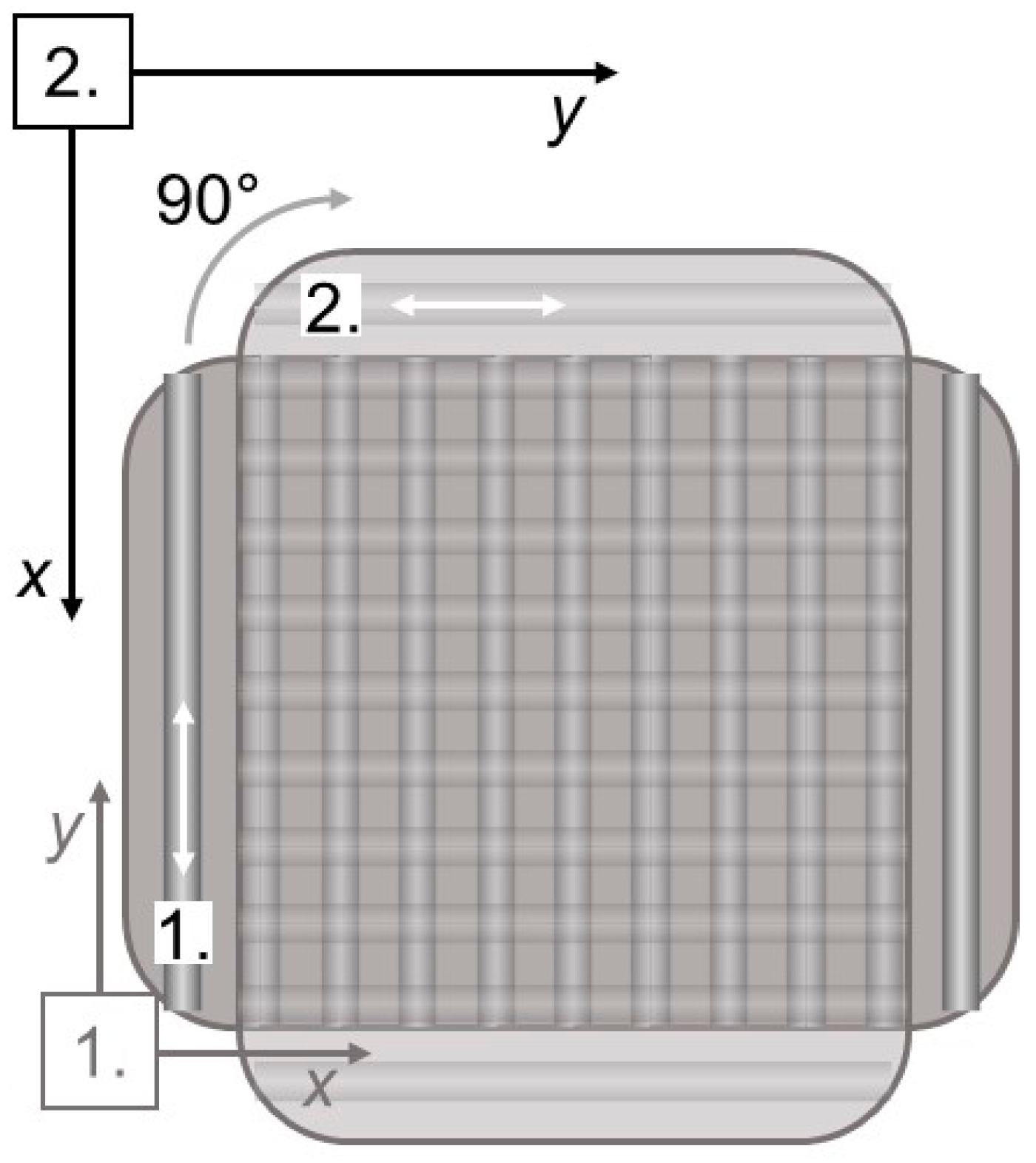

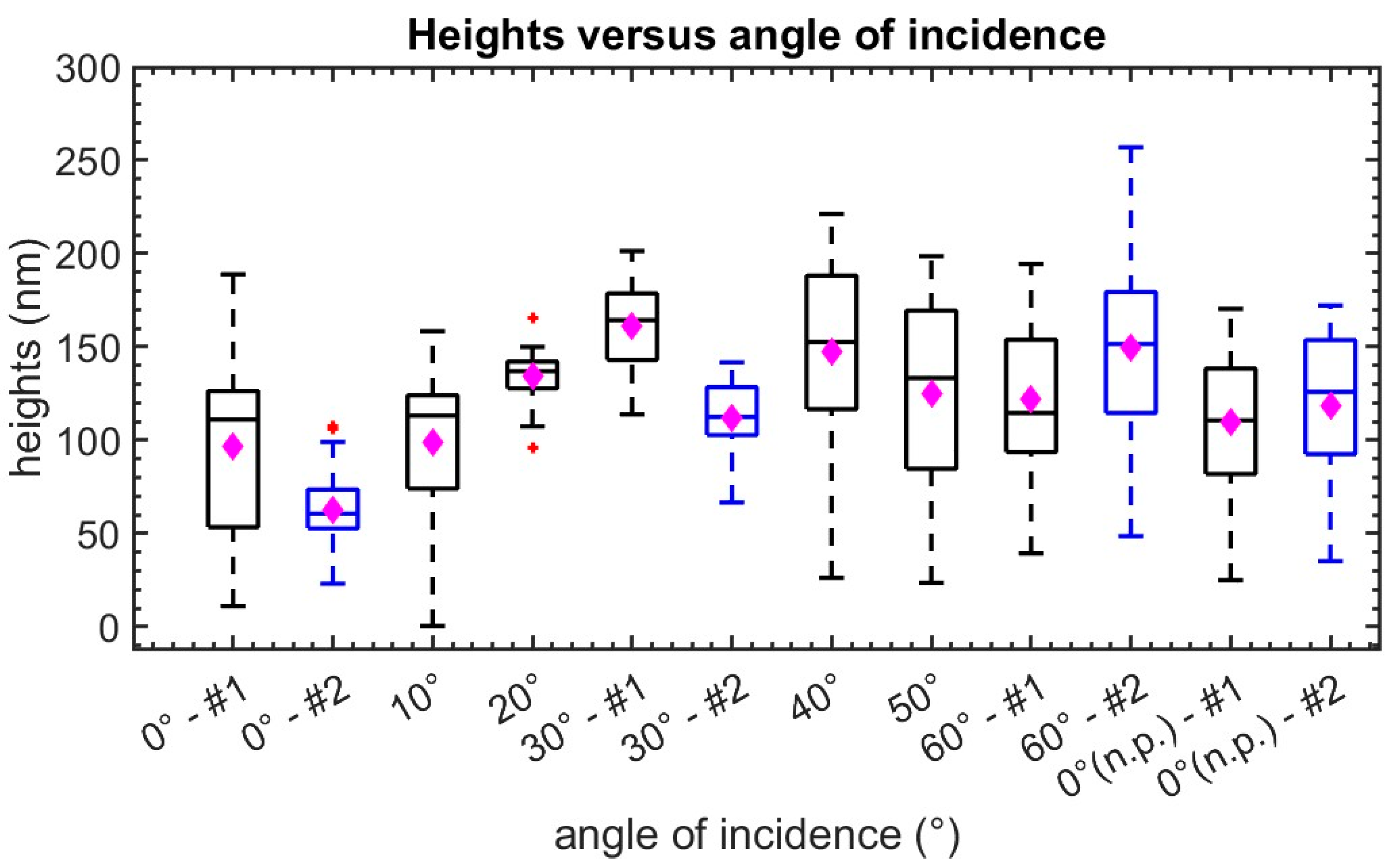

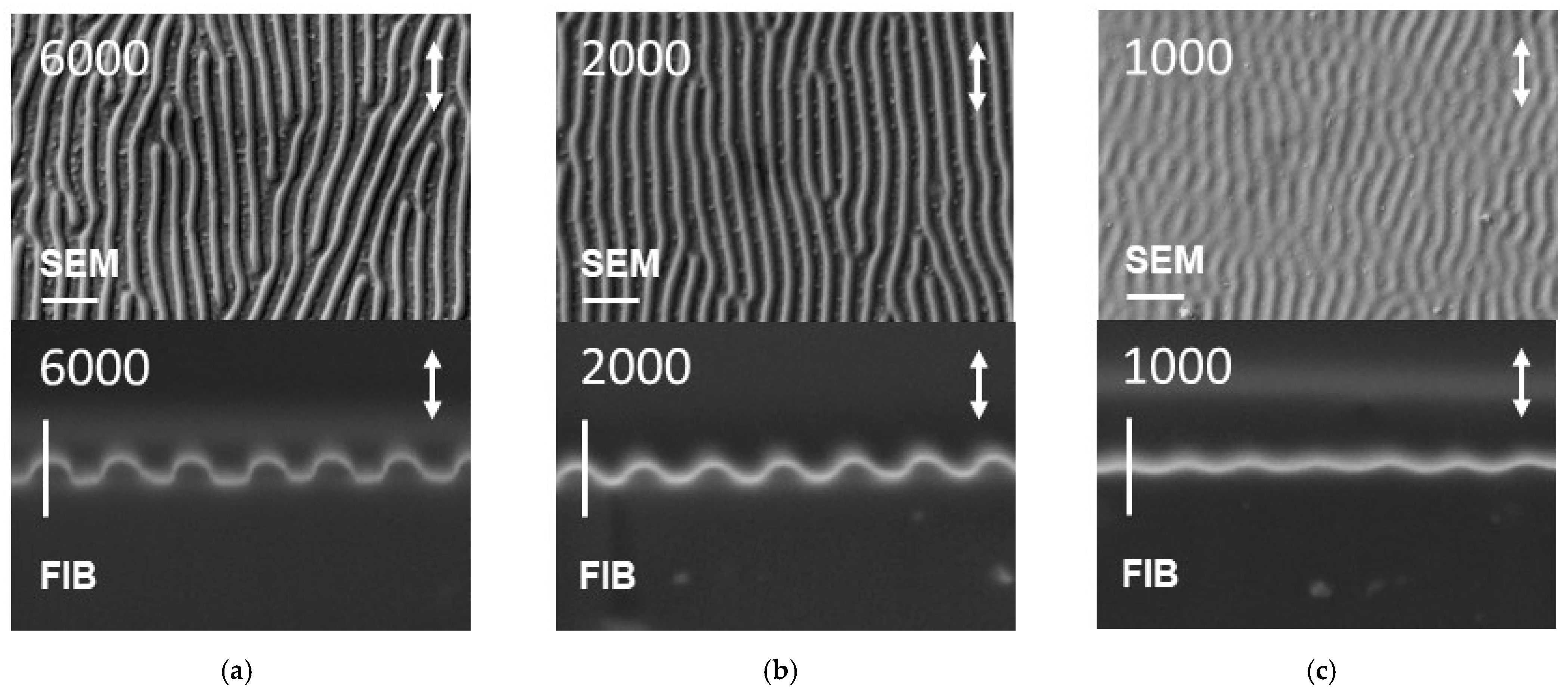




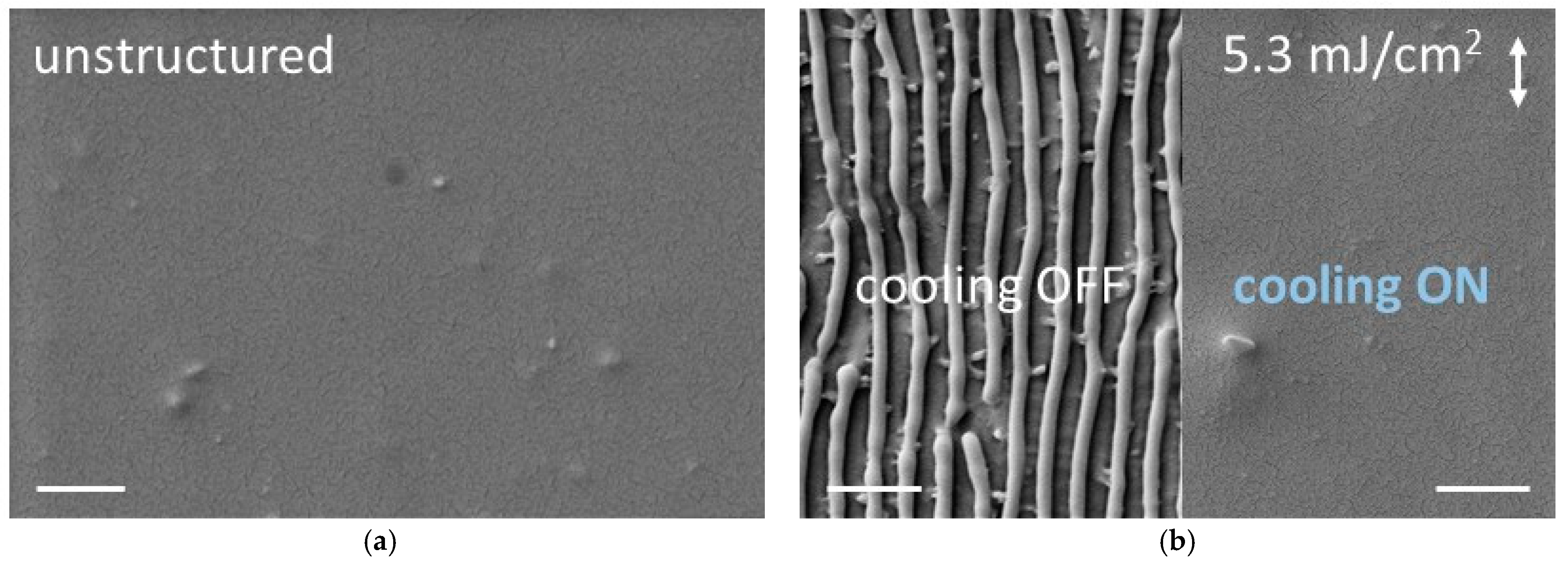




| Thickness t (μm) | 1.4 | 6 | 12 | 50 (Reference) | Linear Fit |
|---|---|---|---|---|---|
| fluence ϕ of about 4.2 to 4.5 mJ/cm2 | |||||
| spatial periods Λ (nm) | 334 ± 7 (±2%) | 335 ± 2 (±0.6%) | 396 ± 5 (±1%) | 334 ± 6 (±2%) | 6.10 t + 316 |
| fluence ϕ of about 5.7 to 6.2 mJ/cm2 | |||||
| spatial periods Λ (nm) | 304.0 ± 0.8 (±0.3%) | 326 ± 4 (±1%) | 360 ± 4 (±1%) | 327 ± 6 (±2%) | 5.39 t + 295 |
Disclaimer/Publisher’s Note: The statements, opinions and data contained in all publications are solely those of the individual author(s) and contributor(s) and not of MDPI and/or the editor(s). MDPI and/or the editor(s) disclaim responsibility for any injury to people or property resulting from any ideas, methods, instructions or products referred to in the content. |
© 2024 by the authors. Licensee MDPI, Basel, Switzerland. This article is an open access article distributed under the terms and conditions of the Creative Commons Attribution (CC BY) license (https://creativecommons.org/licenses/by/4.0/).
Share and Cite
Buchberger, G.; Kührer, M.; Hesser, G.; Heitz, J. Nanoscale Dots, Grids, Ripples, and Hierarchical Structures on PET by UV Laser Processing. Photonics 2024, 11, 184. https://doi.org/10.3390/photonics11020184
Buchberger G, Kührer M, Hesser G, Heitz J. Nanoscale Dots, Grids, Ripples, and Hierarchical Structures on PET by UV Laser Processing. Photonics. 2024; 11(2):184. https://doi.org/10.3390/photonics11020184
Chicago/Turabian StyleBuchberger, Gerda, Martin Kührer, Günter Hesser, and Johannes Heitz. 2024. "Nanoscale Dots, Grids, Ripples, and Hierarchical Structures on PET by UV Laser Processing" Photonics 11, no. 2: 184. https://doi.org/10.3390/photonics11020184
APA StyleBuchberger, G., Kührer, M., Hesser, G., & Heitz, J. (2024). Nanoscale Dots, Grids, Ripples, and Hierarchical Structures on PET by UV Laser Processing. Photonics, 11(2), 184. https://doi.org/10.3390/photonics11020184





